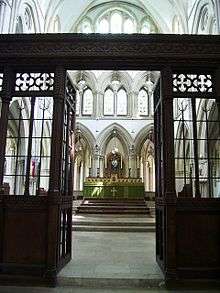St Wilfrid's Church, Harrogate
| St Wilfrid's Church | |
|---|---|
|
| |
| Denomination | Church of England |
| Churchmanship | Traditional Catholic |
| Website | www.stwilfrid.org |
| History | |
| Dedication | St Wilfrid of Ripon |
| Administration | |
| Parish | St. Wilfrid, Harrogate |
| Deanery | Harrogate |
| Archdeaconry | Richmond and Craven |
| Episcopal area | Ripon |
| Diocese | Leeds |
| Province | York |
| Clergy | |
| Vicar(s) | Fr Gordon Newton SSC |
| Rector | Fr Gary Waddington SSC |
| Honorary priest(s) |
Fr Gareth Jones Fr Tim Burrell |
| Laity | |
| Churchwarden(s) |
Mr M Whittaker Mr T Rhodes |
St Wilfrid's Church, Harrogate is an Anglican parish church in the town of Harrogate, North Yorkshire, England. It is a Grade I listed building, the only such building in Harrogate. It was designed by the architect Temple Lushington Moore and is his most famous work.
History

The current church building was started in 1904 and the Nave and Baptistry were dedicated for use by 1908. Two sisters, Elizabeth Sophia and Jean Trotter gave large donations to fund the completion. The first gift of £10,000 (£857,111 in 2016),[1] allowed the nave to be completed by 1914.
Temple Moore died in 1920 and a bequest from Jean Trotter in 1924 of £32,000 (£1,630,036 in 2016),[1] allowed the completion of the north and south transepts. The work was completed in 1927 by Temple Moore's son-in-law, Leslie Moore. In 1928, the organ was installed in the North Transepts.
William Gunn left £9,000 (£557,981 in 2016),[1] in his will of 1932 and this allowed the church hall to be built. The hall features a lamella roof, the only example of such a construction in the United Kingdom.
In 1935, the generosity of Sir William Nicholson allowed the Lady Chapel to be built. While most of the work after Temple Moore's death in 1920 had been sympathetic to his sketches, Leslie Moore's design for the Lady Chapel was radically different from the small chapel proposed by this father-in-law.
Reception
The church is widely considered to be Temple Moore's greatest work. It subtly dominates the Harrogate skyline, and Pevsner considers it to be "the biggest and by far the best of Harrogate's churches, the masterwork of Temple Moore". Sir Aston Webb highlights its national importance, and goes as far as to say it is "perhaps the most beautiful of all parish churches I know" (Yorkshire Post, 8 June 1935). The church is subject of Sir John Betjeman's poem "Perp. Revival i' the North", in which its elegant grandeur and traditional liturgy are identified. Elsewhere, he remarks how the building seems vast in every direction, enhanced by what he describes as "Edwardian vistas".
Leslie Moore's faithful completion of his father-in-law's masterpiece is a great credit to him. His skill as an architect is further credited by the Church Times for February 24, 1950, which writes "Mr Leslie Moore has outdone his uncle by adding the loveliest part of the building - the Lady Chapel". In a local newspaper, reviewing the dedication of the Lady Chapel, it was described as a "glorious pageant in Christian architecture".
Music
Musicians
The Parish is served by a Director of Music, Leonard Sanderman (since 2014) and Parish Organist, Timothy Gray (since 1977). Notable former organists include David Halls. Since the dedication of the building, there has been an uninterrupted choral tradition in the parish. A music foundation was established in 2015 to enhance the musical life of the parish, and improve the musical facilities available.
Organ
The Harrison and Harrison organ in the North Transept was installed in 1928 upon completion of this part of the church. Its outline form is based on a 1912 sketch by Temple Moore, with minor alterations by Leslie Moore and the Harry Harrison. Due to a lack of funds, no case proper was realised. The instrument was voiced by Arthur Harrison, and is one of the best preserved examples of his work. As such, the organ received Grade II*-listing from the British Institute of Organ Studies.
Due to lack of funds, eight stops, three chests, and one reservoir were not installed in 1928. Generations since have displayed a continuous commitment to the completion of the organ, with additions (mostly sympathetic) in 1942, 1968, 1972, 1982, and 2011. A restoration project is underway, in which the organ will restored, and completed to the 1928 contract, whilst seeking to preserve as much of the later additions to the instrument as possible within the concept envisaged by Arthur Harrison.
Bells
St Wilfrid's Church has eight bells, for change-ringing, in the central tower. The heaviest six bells, cast from redundant bells from High Hoyland, were installed in 1973. The [tenor] of the peal weighs 6cwt and 3lbs and is tuned to C. In 1976 two redundant bells were obtained and the ring was increased to eight in 1977.
Additionally there is a Sanctus bell in the South-East tower.
Incumbents
|
|
See also
References
| Wikimedia Commons has media related to St Wilfrid's, Harrogate. |
- 1 2 3 UK CPI inflation numbers based on data available from Gregory Clark (2015), "The Annual RPI and Average Earnings for Britain, 1209 to Present (New Series)" MeasuringWorth.
- The Story of St Wilfrid's church, Harrogate. Third Edition. ca. 1950s
- The Parish Church of St Wilfrid, Harrogate. ca. 1990s
- Specification of the organ
Coordinates: 53°59′43″N 01°33′11″W / 53.99528°N 1.55306°W